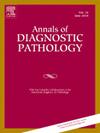头颈部鳞状细胞癌的组织病理学变异:拉丁美洲的一项多中心研究。
IF 1.4
4区 医学
Q3 PATHOLOGY
引用次数: 0
摘要
头颈部鳞状细胞癌(HNSCC)的组织病理学变异并不常见,约占所有HNSCC病例的5- 15%。由于其异质的临床病理特征,正确的诊断可能具有挑战性。我们的目的是分析拉丁美洲人群中HNSCC变异的临床病理、组织化学(HC)、免疫组织化学(IHC)和原位杂交(ISH)结果。根据2023年世界卫生组织标准,回顾性评估了1415例HNSCCs。六十六人(4.6%)HNSCC变体,包括疣状癌(VC, n = 21),嗜碱性鳞状细胞癌(BSCC n = 13),梭形细胞鳞状细胞癌(SCSCC, n = 8) adenosquamous癌(ASC, n = 6),透明细胞鳞状细胞癌(CCSCC, n = 4) cuniculatum癌(CC, n = 4) lymphoepithelial癌(LC, n = 3),乳头状鳞状细胞癌(PSCC, n = 2), acantholytic鳞状细胞癌(为n = 2),色素鳞状细胞癌(PigSCC, n = 2),癌和杆状的表现型(CRP, n = 1)。免疫组化(IHC)支持的组织形态学(主要是p53和Ki-67)可以诊断大多数VC、CC、PSCC、ASCC和PigSCC。突变型p53在BSCCs中很常见。SCSCC的诊断需要免疫组化来突出大多数病例的上皮表型,几乎所有这些病例都表现为突变型p53模式。人乳头瘤病毒相关的BSCC和SCSCC是罕见的。免疫组化支持的HC分析与大多数ASC和CCSCC诊断相关。由于炎症成分,免疫组化可能是突出LC细胞的关键,具有潜在的爱泼斯坦-巴尔病毒感染。c反应蛋白的诊断依赖于免疫组化和ISH的结果,具有严格的临床相关性。因此,详细的HNSCC变异临床病理特征是基础,因为它提供了诊断、治疗和预后影响的有价值的数据。本文章由计算机程序翻译,如有差异,请以英文原文为准。
Histopathological variants of head and neck squamous cell carcinomas: A multicenter study in Latin America
Histopathological variants of head and neck squamous cell carcinoma (HNSCC) are uncommon and account for approximately 5–15 % of all HNSCC cases. Owing to their heterogeneous clinicopathological characteristics, a correct diagnosis can be challenging. We aimed to analyze the clinicopathological, histochemical (HC), immunohistochemical (IHC), and in situ hybridization (ISH) findings of HNSCC variants in a Latin American population. In total, 1415 HNSCCs were retrospectively evaluated in accordance with the 2023 World Health Organization criteria. Sixty-six (4.6 %) HNSCC variants were identified, including verrucous carcinoma (VC, n = 21), basaloid SCC (BSCC, n = 13), spindle cell SCC (SCSCC, n = 8), adenosquamous carcinoma (ASC, n = 6), clear cell SCC (CCSCC, n = 4), cuniculatum carcinoma (CC, n = 4), lymphoepithelial carcinoma (LC, n = 3), papillary SCC (PSCC, n = 2), acantholytic SCC (ASCC, n = 2), pigmented SCC (PigSCC, n = 2), and carcinoma with rhabdoid phenotype (CRP, n = 1). Histomorphology, supported by IHC (mainly p53 and Ki-67), allows the diagnosis of most cases of VC, CC, PSCC, ASCC, and PigSCC. Mutant-type p53 pattern is common in BSCCs. SCSCC diagnosis requires IHC to highlight the epithelial phenotype in most cases, almost all of which exhibit a mutant-type p53 pattern. Human papillomavirus-associated BSCC and SCSCC are rare. HC analysis supported by IHC is relevant for most ASC and CCSCC diagnoses. Owing to the inflammatory component, IHC may be crucial for highlighting LC cells, with potential Epstein–Barr virus infection. CRP diagnosis relies on IHC and ISH findings in strict clinical correlation. Therefore, detailed clinicopathological characterization of HNSCC variants is fundamental because it provides valuable data with diagnostic, therapeutic, and prognostic impacts.
求助全文
通过发布文献求助,成功后即可免费获取论文全文。
去求助
来源期刊
CiteScore
3.90
自引率
5.00%
发文量
149
审稿时长
26 days
期刊介绍:
A peer-reviewed journal devoted to the publication of articles dealing with traditional morphologic studies using standard diagnostic techniques and stressing clinicopathological correlations and scientific observation of relevance to the daily practice of pathology. Special features include pathologic-radiologic correlations and pathologic-cytologic correlations.

 求助内容:
求助内容: 应助结果提醒方式:
应助结果提醒方式:


